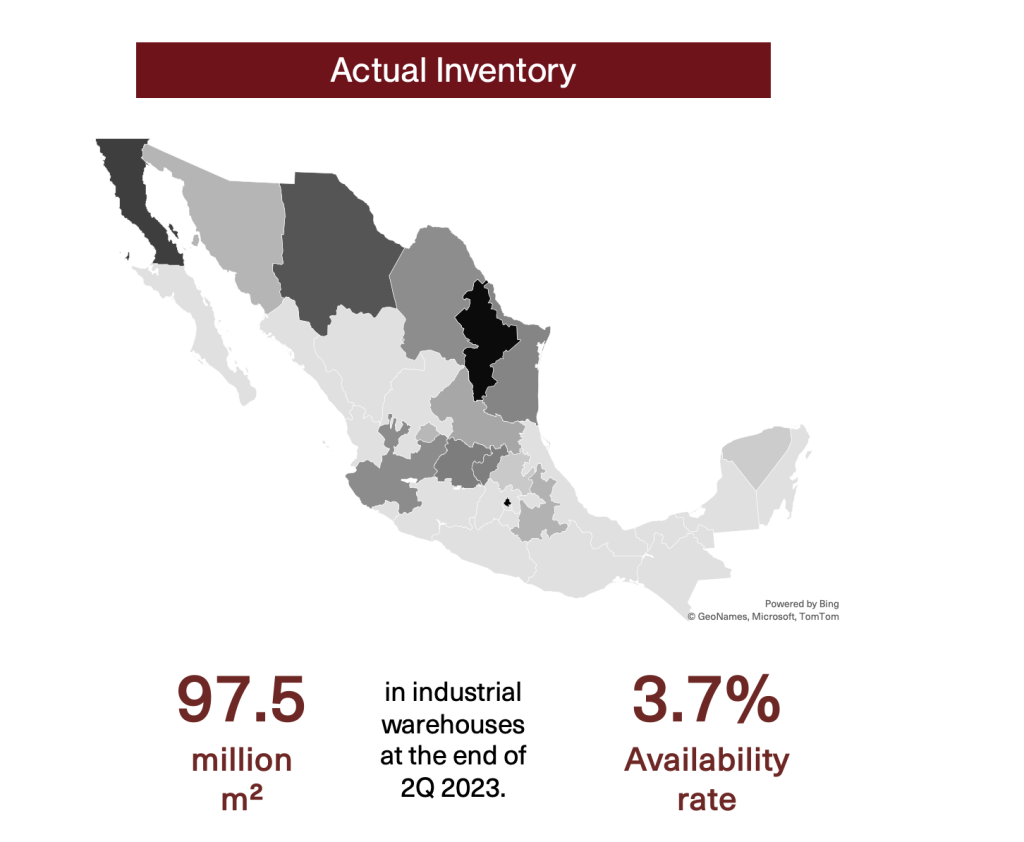
Mexico finds itself at an unprecedented opportunity to address the growing demand in the industrial sector. Recently, announcements of Foreign Direct Investment (FDI) exceeding 100 billion US dollars have been made, with foreign companies looking to relocate their operations to Mexican territory to meet the needs of the US market.
The relocation of these companies opens extensive opportunities for various sectors linked to construction, which can capitalize on the demand for materials and services for the construction of industrial warehouses in the coming years.
Industrial Market in México
What is being discussed in the media?
The industrial spaces sector is characterized by its fundamental unit of measurement: the square meter. In this context, various key aspects of the market, such as availability, construction, and inventory, are articulated around this unit of measurement.
Therefore, it is imperative that any company interested in assessing its potential in this sector estimates its products and services (tons, liters, hours, pieces, personnel, etc.) in terms of their use per square meter, which we will call usage density.

Historical Growth of the Industrial Market
The industrial sector has experienced significant growth, evidenced by a national Compound Annual Growth Rate (CAGR) of 4.1% between 2019 and 2023. However, certain markets, especially attractive for nearshoring, have seen double-digit growth figures in the last two years.
With a historical inventory reaching 97.5 million square meters by the second quarter of 2023, the notably low availability rate stands at 3.7% nationwide, the lowest on record. Given this landscape and recent investment announcements, Delphus Consulting has undertaken the task of projecting the growth of square meters in the industrial market until 2030
Industrial Warehouse Growth/Nearshoring

horizons, based on historical growth data from 2019-2023 from Datoz.

Main factors that can affect the forecast:
-
- Availability of electricity.
-
- Security and road infrastructure.
-
- Political stability.
-
- Access to water.
Understanding the Market and its segmentation
Segmentation
To obtain a more accurate assessment of the potential offered by the growth of industrial spaces to our company, it is crucial to move away from a totalistic perspective and proceed to subdivide or segment the market according to the particularities that most affect our industry. Subsequently, we must estimate individual potential for each segment, considering the demand intensity in each of them.
Among the possible segmentation criteria are the type of construction system, ABC class of warehouses, type of use (whether for heavy or light industry), type of activity or sector (such as storage, production, food industry, among others), or whether the construction’s origin is speculative or Build to Suit.
Construction Systems
The analysis of the industrial warehouse market, particularly concerning construction materials, is based on the understanding of five fundamental elements in its building process. Each of these components has needs that can be considered independently. The components that make up an industrial warehouse are:


Important points to consider:
-
- There are different solutions/materials for each component, and they are evaluated independently.
-
- Decision-making regarding which material to use is done at the component level and is multifactorial through a cost/functionality iteration.
Classes of Industrial Warehouses Type A, B and C
Although there is no strict regulation that defines the precise characteristics a industrial building must possess to be classified as Class A, B, or C, and this classification can vary according to the evaluator’s criteria, generally, the categorization is affected by the quality of implemented systems and the dimensions of open spaces and heights.
Some of the most common characteristics, although not necessarily determining, according to the class, include:

Key factors in the decision-making process
Decision-making process
To ensure that our value proposition effectively reaches decision-makers regarding the acquisition or contracting of our products or services, it is imperative to understand the decision-making process in three fundamental axes and distinguish them by segment:
Key Players: Identify who are the individuals with decision-making or influencing
capacity in the process (Networking Target).
Needs: Understand which attributes or characteristics generate the most value for the involved actors (Value Proposition).
Timing: Determine the critical moments within the industrial warehouse construction cycle in which it is pertinent to establish contacts with relevant actors (Commercial
Management).
General process of the development of an industrial warehouse and the actors involved.

The importance of identifying influential actors and investigating their needs
In the process of developing an industrial warehouse, influential actors play fundamental roles and exert their influence on the selection of materials used throughout the entire process, from its inception to its conclusion. This influence may vary depending on the specific component of the industrial warehouse and the particular role that each actor plays in the process.
For example, in the selection of materials for the structural component, the structural engineer may exert significant influence due to their expertise in
structural engineering, as well as their understanding of the loads and design requirements associated.
In summary, it is vital to identify these actors, as each component of the industrial warehouse may require consideration of different variables and factors, and the choice of materials/services may be subject to the influence of various participants in the process.

Framework to design a winning commercial strategy
Based on the aspects previously examined, we have developed the following framework that will serve as a guide to design a commercial strategy aimed at taking advantage of the additional demand that will arise in the industrial sector as a result of the nearshoring effect:

In Delphus Consulting we help you diagnose, design, and implement customized solutions that guarantee a bridge that connects your company’s strategy with the necessary execution.



